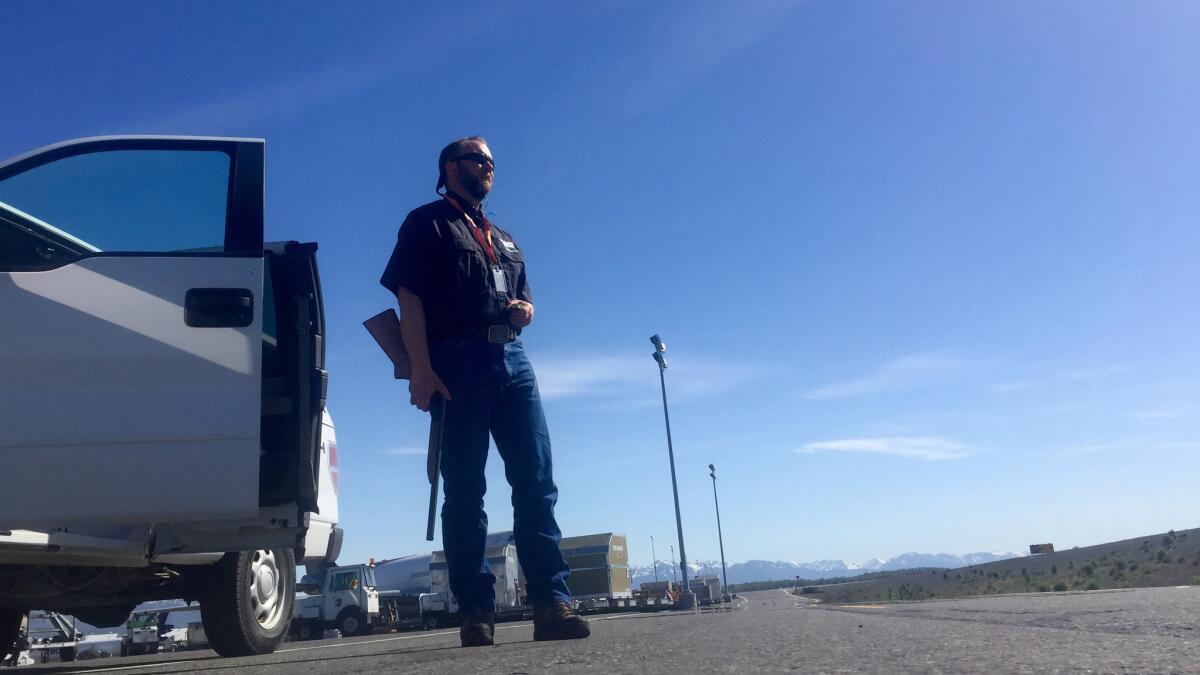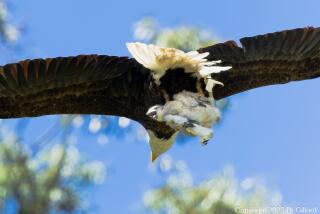Bald eagles pose an increasing risk at U.S. airports. Here’s how officials are trying to protect them.

- Share via
Reporting from Anchorage — Deep in an industrial neighborhood of South Anchorage, a bald eagle known only as No. 1526 eats donated salmon and pet store rats as he is trained for use as a classroom exhibit.
Life could be worse. The eagle arrived here in October after he was hit by a plane in the stormy island town of Sand Point and somehow survived, rushed to emergency wing surgery. At a time when eagles are so prevalent that it’s hard to find zoos willing to take them, No. 1526 is young enough to learn new tricks.
“He’s a pretty lucky bird,” said Amy Kilshaw, an avian rehabilitation coordinator for the Anchorage-based Bird Treatment and Learning Center.
“When you say, ‘He got hit by an airplane,’ everyone gets taken aback by that,” Kilshaw said. The eagle regarded her seriously from his perch a few feet away, ruffling an amputated wing. “Especially because, obviously, he’s still here.”
No. 1526 might be fortunate, but he’s not alone. A side effect of one of the great American conservation success stories, collisions between airplanes and bald eagles are on the rise across the country.
Reports to the Federal Aviation Administration of bald eagles struck by airplanes have increased 2,200% since 1990 as the once-threatened species repopulates its historical range. The U.S. Department of Agriculture predicts that eagles, which can weigh as much as a Thanksgiving ham and slam into fast-moving planes as if they were fired from a cannon, pose an increasing risk at U.S. airports.
The FAA counted 17 such collisions last year nationwide, including four in Alaska. Although the chances of hitting the national symbol while flying are low, the stakes are high. The average collision costs $425,000 in repairs.
Eagle populations increased fivefold in the Pacific Northwest, Chesapeake Bay, Great Lakes and Florida over the past 20 years. Over the same period, airlines replaced older, louder jets with quieter turbofan engines that prove harder for birds to detect and evade, according to the USDA’s Wildlife Services division.
“We did start to see a sudden increase in [bald eagle] strikes, and we think that has to do with the population increase,” said Mike Begier, who coordinates the federal airport wildlife hazards program for the USDA and oversees an FAA database of reported bird strikes.
“Because of their large size, sometimes the consequences can be really dramatic,” he said.
Alaska, in particular, has become a proving ground of sorts for the dangers bald eagles can pose to planes.
In 2010, passengers on an Alaska Airlines flight from Sitka to Seattle heard a loud bang during takeoff, followed by a tremor throughout the Boeing 737. An eagle had been sucked into the left engine, which burst into flames, according to a report to the FAA. The plane aborted takeoff and taxied back to the airport terminal.
------------
For the record
8:37 p.m.: An earlier version of this story said the Alaska Airlines flight out of Sitka that was struck was a Boeing 747. It was a Boeing 737.
------------
When a replacement jet took off with the stranded passengers, it hit an eagle too.
“That was a real big one that really got people thinking about this issue with bald eagles,” said Begier, who last year co-authored the first research report on the danger of bald eagle strikes at U.S. airports.
The paper concluded that bald eagle collisions represent “an increasing problem” for aviators and called for research into tactics for preventing crashes. A month after the research article was published, a bald eagle was sucked into the engine of a 747 departing Ted Stevens Anchorage International Airport, causing more than $1 million in damage.
When does a goose become an elephant? The instant it hits an aircraft.
— Mike Begier, federal airport wildlife hazards program coordinator.
Nowhere are more eagles struck than Alaska, where 60 reports of strikes or near strikes have been logged since 1990. Except for gulls, aircraft collisions with eagles are more common here than for any other bird, FAA records show.
For the first time, the problem appeared to turn deadly April 20 when a small propeller plane carrying four people on an aerial and surveying photography flight smashed into the dense spruce and birch trees near Anchorage. Everyone on board was killed.
Investigators found a “foreign substance” on the plane and sent samples to the Smithsonian Institute for DNA testing. The Cessna 172 had hit a juvenile bald eagle, the tests concluded. Unless a surprise cause is discovered in the ongoing investigation, the crash would mark the first human deaths following an eagle strike in the U.S.
“We don’t know if went through the cabin or the cockpit. Through the windscreen or if it took out one of the flight control mechanisms,” said Clint Johnson, the National Transportation Safety Board chief for Alaska.
With an average weight of 9 to 12 pounds, eagles can shatter windshields or shut down a jet engine. Of the 234 eagle collisions with civil and military aircraft reported to the FAA between 1990 and 2013, more than half caused damage, Begier and his colleagues found.
“When does a goose become an elephant?” Begier asked, paraphrasing an old poster used in Canada to warn pilots of dangerous bird strikes. “The instant it hits an aircraft.”
Efforts by the USDA’s National Wildlife Research Center to develop new lighting systems for aircraft could help reduce collisions by making it easier for eagles and other species to spot approaching planes, Begier said. The National Transportation Safety Board encouraged such research following the 2009 “Miracle on the Hudson” landing of a passenger jet that ingested a flock of Canada geese.
On the front lines are Wildlife Services biologists like Spencer Nelsen, who has patrolled the Ted Stevens Anchorage International Airport for three years. There have been two eagle strikes in that time, he said.
Ringed by a moose-proof fence above a blustery inlet, the airport is a pit stop for global travel and one of the busiest cargo hubs in the world. Eagles like to soar on thermals just off the end of the runway, Nelsen said as he patrolled the airport on a sunny afternoon this spring.
“We’re not doing them any favors by letting them stay here,” he said of the eagles. “It’s really a matter of time before something bad happens.”
While no longer listed under the Endangered Species Act, the birds remain protected under federal law. Even at airports, their nests can only be moved with a permit and then only if there are no eggs inside.
See more of our top stories on Facebook >>
The biologist pulled to a stop. High above, a familiar bald eagle was back, gliding in wide, lazy loops. Nelsen once removed a tree where the bird – notable for a distinctive white mark on its wing -- nested near the airport, but the eagle remains. Ravens are craftier. They learn to avoid the planes and flee at the sight of his white pickup.
Nelson pulled a shotgun from the cab, loading noisemaker shells designed to scare the bird to safety. The 12-gauge boomed three times. The eagle paid no mind as another jet roared in for a landing.
The driver of a nearby UPS truck watched the commotion, leaning out of the window of his cab for a better look.
Good luck, he said to Nelson. “That poor guy’s been around here all day.”
ALSO
Florida attorney general asked Trump for donation before nixing fraud case
No charges filed against boy’s mother in gorilla death case, Ohio prosecutor says
U.S. cities see unexplained rise in violent crimes this year
Hopkins is a special correspondent.
More to Read
Sign up for Essential California
The most important California stories and recommendations in your inbox every morning.
You may occasionally receive promotional content from the Los Angeles Times.










